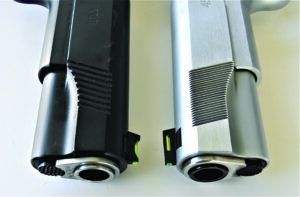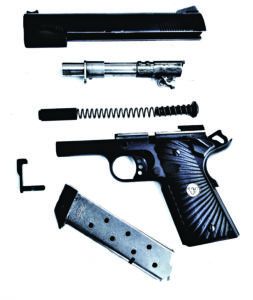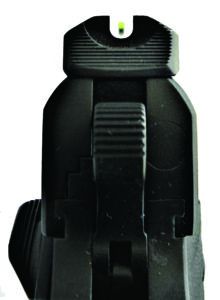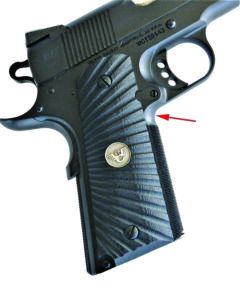After testing five high-end 1911 handguns in the July 2020 issue, we got four more guns to conduct an even greater and more demanding test of steel. The 1911 handgun has continued in service, even at the top of the heap, in competition and service use long after other mechanical designs have been out of service or relegated to the museum. A low bore axis, straight-to-the-rear trigger compression, a grip that fits most hands well, and a design that lends itself well to customization has the potential to suit every shooter. Among expensive 1911 handguns, the primary difference in the pistols isn’t the number of features, although self-luminous sights and extended controls have a bearing on price. Rather, the reason they are so expensive is the quality of machine work and manufacture. The trigger compression, barrel fit, and frame-to-slide fit are usually as good as human hands can make them, and the cosmetics are almost always top notch. Such guns will almost always be able to outshoot their owners, and their operation is flawlessly reliable.

All of the pistols tested are 5-inch-barrel steel-frame 1911 handguns. This means they are not difficult to control with full-power ammunition. Our contestants were:
- The Dan Wesson Specialist 01802 45 ACP, $1732. We found a Specialist “on sale” for $1575 and moved too late to obtain it, and we also located a few for $2020. It seems $1700 is about average. Our test gun cost us a bit more than the Springfield and a thousand dollars less than the Wilson Combat and Les Baer, on average. While the Dan Wesson may be a “production” pistol, unless the pistol is modified one at a time by a custom pistolsmith, most high-end 1911 handguns are products of a certain package or formula, so its factory SKU didn’t put us off one bit. The Dan Wesson Specialist is the heaviest 1911 tested at 43 ounces unloaded — just three ounces less than a 6-inch-barrel 357 Magnum Python.
- The Les Baer 572 Hemi 45 ACP, $2853. This pistol is named after Les Baer’s drag car. It is a distinctive pistol with a chrome finish, black grips, and black Dupont S coated controls. Some of the raters were left cold by the color scheme, others were very enthusiastic, it is that type of pistol. The pistol features both standard and forward cocking serrations. They are nicely machined with a finer pattern than the other handguns.
- The Springfield Armory 1911 TRP PC9107L18 45 ACP, $1648. We found this pistol listed for $1299 at several outlets, but also saw it as out of stock. The Tactical Response Pistol is a factory-production 1911 turned out by the Springfield custom shop. You cannot upgrade a Loaded Model by gunsmithing it into a TRP; the TRP is a tighter gun. The frame is fitted to the slide, and the result is a very tight pistol — it seemed as tight as the Wilson Combat or Dan Wesson pistols.
- The Wilson Combat Close Quarters Battle 45 ACP, $2865. The Close Quarters Battle is the flagship combat pistol offered by Wilson Combat. The CQB is manufactured using the same parts you might order to build your own Wilson Combat pistol, save the parts fitted in house by Wilson Combat gunsmiths. A trademark of the CQB is excellent barrel fitting. The barrel-to-slide and bushing fit are tight, and the barrel crown is well done. This pistol’s steel frame and slide have an Armor Tuff coating that is evenly applied and seems durable, we thought.

These are four different handguns with different downrange performance, but the bottom line connecting them is reliability. To check for this, we fired the 80 rounds of ammunition on the combat course, mixing up the lot with mostly practice loads, 40 rounds of Black Hills Ammunition 200-grain LSWCs, 20 rounds of Fiocchi 230-grain FMJs, and 20 rounds of a handload consisting of the Hornady 230-grain XTPs over enough Titegroup powder for 855 fps.
Among the guns, the Les Baer 572 Hemi is primarily designed for extreme accuracy. The Wilson Combat CQB is a formidable defensive firearm. The Dan Wesson Specialist is for service use. The Springfield Tactical Response pistol is intended to offer excellent performance, but it isn’t as expensive as the Springfield Professional, which is an FBI SWAT pistol, and it was deemed a good match on the lower end of high-end prices.
Gun Tests Grade: A (OUR PICK)
$2865
We lubricated the pistol and then fired an 80-round combat course with the same loads used in the other handguns. There were no failures to feed, chamber, fire, or eject. The CQB pistol turned in the best combat groups of the test. While the pistols were all excellent in this regard, the primary advantage of the CQB, the higher grip, is noticeable to an experienced shooter. A combination of grip treatment, excellent adhesion of the Wilson sunburst-type grips, and a good trigger mechanism were part of the advantage.
| Action Type | single action, short recoil-operated locked breech |
| Overall Length | 8.5 in. |
| Overall Height | 5.5 in. |
| Maximum Width | 1.25 in. |
| Weight Unloaded | 39.0 oz. |
| Weight Loaded | 44.0 oz. |
| Slide Material | Forged steel |
| Slide Retraction Effort | 19.0 lbs. |
| Receiver Material | Steel |
| Finish | Steel |
| Front Strap Height | 2.6 in. |
| Back Strap Height | 3.2 in. |
| Barrel Length | 5.0 in. |
| Grip Thickness Maximum | 1.25 in. |
| Grip Circumference | 5.2 in. |
| Magazines | Two 8-round |
| Rear Sight | U-notch, drift adjustable |
| Front Sight | Dovetailed post, fiber optic tube |
| Sight Radius | 6.4 in. |
| Trigger Pull Weight | 4.5 lbs. |
| Trigger Span | 2.8 in. |
| Safeties | Slide lock, grip |
| Warranty | None written |
| Telephone | (800) 955-4856 |
| Website | WilsonCombat.com |
| Made In | U.S.A. |

In common with the Les Baer, this pistol features forward cocking serrations. The sights are the familiar fiber-optic front and a set of modern combat sights in the rear. The rear sight is serrated on the lower rear and features a ledge for cocking the slide on a belt or boot heel. A U-shaped rear notch allows getting on target quickly but remains tight enough for real precision. The frame front strap is checkered in a custom-grade pattern that goes high on the front strap. The frame is cut just behind the trigger guard to raise the front strap a bit, making for a better feel and a superior natural point. Trigger-guard geometry differs from the standard 1911 as well. Wilson Combat gets the hand high up on the gun by re-engineering important dimensions. The pistol does not have an ambidextrous safety. The slide-lock safety indents in a positive manner. The mainspring housing is nicely checkered. The upswept beavertail safety is well designed and releases its hold on the trigger halfway into trigger compression. This beavertail seems to get the hand higher than the Les Baer, in our opinion.

The pistol sports a dark physical vapor deposition finish. This is a dark, durable, and functionally attractive coating. Trigger compression is 4.5 pounds. The trigger is smooth with no creep, and it has a rapid, clean reset. This is a good trigger action for a personal-defense pistol.
The rear sight notch was also an advantage in rapid fire. The CQB simply hung on target and stayed there. During the bench-rest firing session, the pistol exhibited good accuracy. As a side note, when we fire for accuracy, we often shoot a beginning group for sighting the pistol and testing sight regulation, usually three rounds at a 7-yard target. When we did so with the CQB, all three shots went into a single ragged cluster less than 0.6 inch wideand perfectly sighted for a combat hold. Fired at 25 yards, the best group was with the Black Hills Ammunition 230-grain JHP at 1.5 inches and 1.9 average.
Our Team Said: We like the Close Quarters Battle. With no consideration for price, it is the overall top choice as a combat pistol.
45 ACP Range Data
All groups were fired at 25 yards from a benchrest position using a MTM Caseguard K Zone pistol rest. We used a Competition Electronics Pro Chrony to measure velocity. The first screen of the chronograph was 10 feet from the muzzle.| Black Hills 230-grain JHP | Les Baer Hemi 572 | Wilson Combat CQB | Dan Wesson Specialist | Springfield TRP |
| Average Velocity | 870 fps | 855 fps | 861 fps | 863 fps |
| Muzzle Energy | 387 ft.-lbs. | 373 ft.-lbs. | 379 ft.-lbs. | 380 ft.-lbs. |
| Small Group | 0.9 in. | 1.5 in. | 1.8 in. | 2.0 in. |
| Average Group | 1.5 in. | 1.9 in. | 2.3 in. | 2.6 in. |
| Fiocchi 230-grain JHP | Les Baer Hemi 572 | Wilson Combat CQB | Dan Wesson Specialist | Springfield TRP |
| Average Velocity | 842 fps | 853 fps | 839 fps | 840 fps |
| Muzzle Energy | 362 ft.-lbs. | 372 ft.-lbs. | 359 ft.-lbs. | 360 ft.-lbs. |
| Small Group | 2.2 in. | 2.3 in. | 2.4 in. | 2.7 in. |
| Average Group | 2.6 in. | 2.6 in. | 2.8 in. | 3.0 in. |
| Handload Hornady 185-grain XTP | Les Baer Hemi 572 | Wilson Combat CQB | Dan Wesson Specialist | Springfield TRP |
| Average Velocity | 1125 fps | 1160 fps | 1140 fps | 1137 fps |
| Muzzle Energy | 520 ft.-lbs. | 553 ft.-lbs. | 534 ft.-lbs. | 531 ft.-lbs. |
| Small group | 1.3 in. | 1.4 in. | 1.9 in. | 1.7 in. |
| Average Group | 1.6 in. | 1.8 in. | 2.2 in. | 2.0 in. |



























